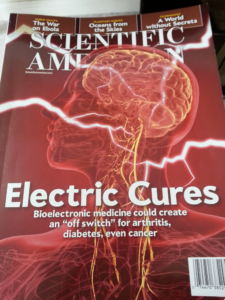RAVANS:TAVNS exhalation synchronized stimulation
Kristen Sparrow • March 22, 2019

 This study by friend of blog Vitaly Napadow, looks at TAVNS (type of ear stim I use in the clinic) and the effect of timing with breathing, exhalation versus inhalation. They are also able to calculate second by second HF HRV. This detailed level of HRV monitoring is way beyond my capabilities. It gives me food for thought in what to look for, however.
This study by friend of blog Vitaly Napadow, looks at TAVNS (type of ear stim I use in the clinic) and the effect of timing with breathing, exhalation versus inhalation. They are also able to calculate second by second HF HRV. This detailed level of HRV monitoring is way beyond my capabilities. It gives me food for thought in what to look for, however.The influence of respiration on brainstem and cardiovagal response to auricular vagus nerve stimulation: A multimodal ultrahigh-field (7T) fMRI study.
Abstract
BACKGROUND:
Brainstem-focused mechanisms supporting transcutaneous auricular VNS (taVNS) effects are not well understood, particularly in humans. We employed ultrahigh field (7T) fMRI and evaluated the influence of respiratory phase for optimal targeting, applying our respiratory-gated auricular vagal afferent nerve stimulation (RAVANS) technique.
HYPOTHESIS:
We proposed that targeting of nucleus tractus solitarii (NTS) and cardiovagal modulation in response to taVNS stimuli would be enhanced when stimulation is delivered during a more receptive state, i.e. exhalation.
METHODS:
Brainstem fMRI response to auricular taVNS (cymba conchae) was assessed for stimulation delivered during exhalation (eRAVANS) or inhalation (iRAVANS), while exhalation-gated stimulation over the greater auricular nerve (GANctrl, i.e. earlobe) was included as control. Furthermore, we evaluated cardiovagal response to stimulation by calculating instantaneous HF-HRV from cardiac data recorded during fMRI.
RESULTS:
Our findings demonstrated that eRAVANS evoked fMRI signal increase in ipsilateral pontomedullary junction in a cluster including purported NTS. Brainstem response to GANctrl localized a partially-overlapping cluster, more ventrolateral, consistent with spinal trigeminal nucleus. A region-of-interest analysis also found eRAVANS activation in monoaminergic source nuclei including locus coeruleus (LC, noradrenergic) and both dorsal and median raphe (serotonergic) nuclei. Response to eRAVANS was significantly greater than iRAVANS for all nuclei, and greater than GANctrl in LC and raphe nuclei. Furthermore, eRAVANS, but not iRAVANS, enhanced cardiovagal modulation, confirming enhanced eRAVANS response on both central and peripheral neurophysiological levels.
CONCLUSION:
7T fMRI localized brainstem response to taVNS, linked such response with autonomic outflow, and demonstrated that taVNS applied during exhalation enhanced NTS targeting.

